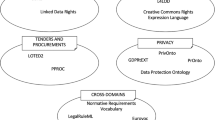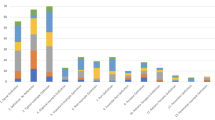Abstract
In this article we describe two core ontologies of law that specify knowledge that is common to all domains of law. The first one, FOLaw describes and explains dependencies between types of knowledge in legal reasoning; the second one, LRI-Core ontology, captures the main concepts in legal information processing. Although FOLaw has shown to be of high practical value in various applied European ICT projects, its reuse is rather limited as it is rather concerned with the structure of legal reasoning than with legal knowledge itself: as many other “legal core ontologies”, FOLaw is therefore rather an epistemological framework than an ontology. Therefore, we also developed LRI-Core. As we argue here that legal knowledge is based to a large extend on common-sense knowledge, LRI-Core is particularly inspired by research on abstract common-sense concepts. The main categories of LRI-Core are: physical, mental and abstract concepts. Roles cover in particular social worlds. Another special category are occurrences; terms that denote events and situations. We illustrate the use of LRI-Core with an ontology for Dutch criminal law, developed in the e-Court European project.
Similar content being viewed by others
References
C. Alchourrón E. Bulygin (1971) Normative Systems Springer-Verlag Wien
Alchourrón, C. and Bulygin, E. (1981). The Expressive Conception of Norms. In Hilpinen, R. (ed.) New Studies in Deontic Logic, 95–124. D. Reidel
J. Allen (1984) ArticleTitleTowards a General Theory of Action and Time Artificial Intelligence 23 123–154 Occurrence Handle10.1016/0004-3702(84)90008-0 Occurrence Handle0567.68025
L. Allen (1997) The Language of Legal Relations, RLL: Useful in a Legal Ontology Toolkit? P. Visser R. Winkels (Eds) Legal Ontologies: Proceedings of the ICAIL-97 workshop ACM New York 47–60
Allen, L. and Saxon, C. (1991). More IA Needed in AI: Interpretation Assistance for Coping with the Problem of Multiple Structural Interpretations. In Proceedings of the Third International Conference on AI and Law. 53–61, Oxford
Austin, J. (1954). The Province of Jurisprudence Determined. London: Weidenfeld and Nicolson. edited by H. L. A. Hart
Baader, F. and Nutt, W. (2002). Basic Description Logics. In Baader, F., Calvanese, D., McGuinness, D. Nardi, D., and Patel-Schneider, P. (eds.), Description Logic Handbook, 47–100. Cambridge University Press
Bentham, J. (1970). An Introduction to the Principles of Morals and Legislation. London: Athlone Press. Edited by J. Burns and H. Hart
Boer, A. and van Engers, T. (2003). A Knowledge Engineering Approach to Comparing Legislation. In Wimmer, M. (ed.), Proceedings of the Conference on Knowledge Management in E-Government. Springer
P. Borst J. M. Akkermans J. L. Top (1997) ArticleTitleEngineering Ontologies International Journal of Human Computer Studies 46 IssueID2/3 365–406 Occurrence Handle10.1006/ijhc.1996.0096
Brachman, R., McGuinness, D., Patel-Schneider, P., Resnick, L., and Borgida, A. (1991). Living with CLASSIC: When and How to Use a KL-ONE-like Language. In Sowa, J. (ed.), Principles of Semantic Networks: Explorations in the Representation of Knowledge: 401–456. Morgan Kaufmann. http://www.cs.man.ac.uk/franconi/dl/course/articles/brachman91living.ps.gz.
B. Bredeweg P. Struss (2004) ArticleTitleCurrent Topics in Qualitative Reasoning AI Magazine 24 13–16
J. Breuker (1994) Components of Problem Solving L. Steels G. Schreiber W. Velde Particlevan de (Eds) A Future for Knowledge Acquisition: Proceedings of the EKAW-94, European Knowledge Acquisition Workshop Springer Verlag Berlin 118–136
Breuker, J. and den Haan, N. (1991). Separating World and Regulation Knowledge: Where is the Logic?’ In Proceedings of the Third International Conference on AI and Law. Oxford, ACM
Breuker, J. and Hoekstra, R. (2004a). Core Concepts of Law: Taking Common-Sense Seriously. In Varzi, A. and Vieu, L. (eds.), Proceedings of Formal Ontologies in Information Systems, FOIS-2004, 210–221. IOS-Press
J. Breuker R. Hoekstra (2004b) DIRECT: Ontology-based Discovery of Responsibility and Causality in Legal Cases T. Gordon (Eds) Proceedings JURIX-2004 IOS-Press Amsterdam 115–126
Breuker, J. and Van De Velde, W. (eds.) 1994. CommonKADS Library for Expertise Modeling: Reusable Problem Solving Components. Amsterdam/Tokyo: IOS-Press/Ohmsha
Brouwer, P. (1990). Samenhang in Recht: een analytische studie (coherence in law). Wolters-Noordhoff
W. Clancey (1985) ArticleTitleHeuristic Classification Artificial Intelligence 27 289–350 Occurrence Handle10.1016/0004-3702(85)90016-5
Damasio, A. (2003). Looking for Spinoza. Putnam
den Haan, N. (1996). Automated Legal Reasoning’. Ph.D. thesis, University of Amsterdam
Dennett, D. (1987). The Intentional Stance. MIT-Press
A. Gangemi N. Guarino C. Masolo A. Oltramari (2003) ArticleTitleSweetening WORDNET with DOLCE AI Magazine 24 13–24
Gangemi, A., Guarino, N., Masolo, C., Oltramari, A., and Schneider, L. (2002). Sweetening ontologies with DOLCE. In Gomez-Perez, A. and Benjamins, V. (eds.), Proceedings of the EKAW-2002, 166–181. Springer
Gangemi, A., Sagri, M., and Tiscornia, D. (2005). A Constructive Framework for Legal Ontologies. In Benjamins, V., Casanovas, P., Breuker, J., and Gangemi, A. (eds.), Law and the Semantic Web, 97–124 Springer Verlag
T. R. Gruber (1993) ArticleTitleA Translation Approach to Portable Ontology Specifications Knowledge Acquisition 5 199–220 Occurrence Handle10.1006/knac.1993.1008
J. Hage B. Verheij (1999) ArticleTitleThe Law as a Dynamic Interconnected System of States of Affairs: A Legal Top Ontology International Journal of Human Computer Studies 51 1034–1077 Occurrence Handle10.1006/ijhc.1999.0297
Hamfelt, A. and Barklund, J. (1990). Metaprogramming for Representation of Legal Principles. In Proceedings of Meta’90, 105–122
H. Hart (1961) The Concept of Law Clarendon Press Oxford
H. Hart T. Honoré (1985) Causation in the Law EditionNumbersecond Oxford University Press New York
P. J. Hayes (1985a) Naive Physics I: Ontology for Liquids J. R. Hobbs R. C. Moore (Eds) Formal Theories of the Common Sense World Ablex Publishing Corporation Norwood 71–108
P. J. Hayes (1985b) The Second Naive Physics Manifesto J. R. Hobbs R. C. Moore (Eds) Formal Theories of the Common Sense World Ablex Publishing Corporation Norwood 1–36
G. V. Heijst A. T. Schreiber B. Wielinga (1997) ArticleTitleUsing Explicit Ontologies for KBS Development International Journal of Human-Computer Studies 46 IssueID2/3 183–292
Hoekstra, R. and Breuker, J. (2006). Commonsense Causal Explanation in a Legal Domain. Artificial Intelligence and Law (forthcoming)
A. Hofstadter J. McKinsey (1939) ArticleTitleOn the Logic of Imperatives Philosophy of Science 6 IssueID4 446–457 Occurrence Handle10.1086/286592
Hohfeld, W. (1919). Fundamental Legal Conceptions as Applied in Legal Reasoning. Yale University Press. Edited by W. W. Cook, fourth printing, 1966
Jansweijer, W., van der Stadt, E., van Lieshout, J., and Breuker, J. (2000). Knowledgeable Information Brokering. In Stanford, B. and Kidd, P. (eds.), E-bussiness: Key Issues, Applications and Technologies. IOS-Press
Kashyap, V. and Borgida, A. (2004). Representing the UMLS Semantic Network using OWL. In Fensel, D., Sycara, K., and Mylopoulos, J. (eds.), The Semantic Web – ISCW 2003, 1–16
H. Kelsen (1991) General Theory of Norms Clarendon Press Oxford
Kim, J. (1998). Mind in a Physical World: An Essay on the Mind-Body Problem and Mental Causation. In Representation and Mind. MIT Press
Kralingen, R. W. V. (1995). Frame-based Conceptual Models of Statute Law. Ph.D. thesis, University of Leiden, The Hague, The Netherlands
Lakoff, G. and Núñez, R. (2000). Where Mathematics Comes From. Basic Books
Lame, G. (2002). Construction d une ontologie à partir de textes. Une ontologie de droit dédié à la recherche dinformation sur le Web’. Ph.D. thesis, Ecole des Mines, Paris, http://www.cri.ensmp.fr/.
Lame, G. (2004). Using NLP Techniques to Identify Legal Ontology Components: Concepts and Relations. In this volume
Lehmann, J. (2003). Causation in Artificial Intelligence and Law: A Modelling Approach. Ph.D. thesis, University of Amsterdam
Lehmann, J., Breuker, J., and Brouwer, P. (2005). CAUSATIONT: Causation in AI & Law. In Benjamins, V., Casanovas, P., Breuker, J., and Gangemi, A. (eds.), Law and the Semantic Web, 77–96. Springer Verlag
Masolo, C., Vieu, L., Bottazzi, E., Catenacci, C., Ferrario, R., Gangemi, A., and Guarino, N. (2004). Social Roles and their Descriptions. In Proceedings of Knowledge Representation Workshop
Massolo, C., Borgo, S., Gangemi, A., Guarino, N., Oltramari, A., and Schneider, L. (2002). The WonderWeb foundational ontologies: Preliminary Report. Technical Report Deliverable D17, version 2, ISTC-CNR (Italy)
McCarty, T. (1989). A Language for Legal Discourse I. Basic Structures. In Proceedings of the Second International Conference on AI and Law, 180–189. Vancouver: ACM
McNamara, P. and Prakken, H. (eds.) (1999). Norms, Logics and Information Systems; New Studies in Deontic Logic and Computer Science. Amsterdam: IOS-Press
M. Minsky (1975) A Framework for Representing Knowledge P. H. Winston (Eds) The Psychology of Computer Vision McGraw-Hill New York 211–277
Mommers, L. (2002). Applied Legal Epistemology: Building a Knowledge-based Ontology of the Legal Domain’. Ph.D. thesis, University of Leiden
A. Muntjewerff J. A. Breuker (2001) Evaluating PROSA, a system to train legal cases J. Moore C. Redfield L. Johnson (Eds) Artificial Intelligence in Education IOS-Press Amsterdam 278–290
O. Pacheco J. Carmo (2003) ArticleTitleA Role Based Model for the Normative Specification of Organized Collective Agency and Agents Interaction Journal of Autonomous Agents and Multi-Agent Systems 6 145–184 Occurrence Handle10.1023/A:1021884118023
R. Patil (1988) Artificial Intelligence Techniques for Diagnostic Reasoning in Medicine H. Shobe AAAI (Eds) Exploring Artificial Intelligence: Survey Talks from the National Conferences on Artificial Intelligence: Morgan Kaufmann San Mateo California 347–379
A. Pease I. Niles (2002) ArticleTitleIEEE Standard Upper Ontology: A Progress Report Knowledge Engineering Review 17 65–70. Occurrence Handle10.1017/S0269888902000395
Pinker, S. (1997). How the mind works. Penguin Books
J. Raz (1972) ArticleTitleLegal Principles and the Limits of Law The Yale Law Journal 81 823–854 Occurrence Handle10.2307/795152
Rector, A. (2002). Medical Informatics. In Baader, F., Calvanese, D., McGuinness, D., Nardi, D., and Patel-Schneider, P. (eds.), Description Logic Handbook, 415–435. Cambridge University Press
R. Schank R. Abelson (1977) Scripts, Plans Goals and Understanding Lawrence Erlbaum New Jersey
J. F. Sowa (2000) Knowledge Representation: Logical Philosophical, and Computational Foundations Brooks Cole Publishing Co Pacific Grove, CA
F. Steimann (2000) ArticleTitleOn the Representation of Roles in Object-Oriented and Conceptual Modelling Data and Knowledge Engineering 35 83–106 Occurrence Handle10.1016/S0169-023X(00)00023-9 Occurrence Handle0948.68053
Stevens, R., Wroe, C., Lord, P., and Goble, C. (2004). Ontologies in Bioinformatics. In Staab, S. and Studer, R. (eds.), Handbook of Ontologies, 635–657. Springer
Strawson, P. (1959). Individuals: An Essay in Descriptive Metaphysics. Routledge
Tulving, E. (1991). Concepts of Human Memory. In Squire, L., Lynx, G., Weinberger, N., and McGaugh, J. (eds.), Memory: Organization and Locus of Change, 3–32. Oxford University Press
A. Valente (1995) Legal Knowledge Engineering: A Modelling Approach IOS Press Amsterdam, The Netherlands
Valente, A. and Breuker, J. (1995). ON-LINE: An Architecture for Modelling Legal Information. In Bench-Capon, T. (ed.), Proceedings of the Fifth International Conference on Artificial Intelligence and Law, 95–104, ACM Press
A. Valente J. Breuker P. Brouwer (1999a) ArticleTitleLegal Modelling and automated reasoning with ON-LINE International Journal of Human Computer Studies 51 1079–1126 Occurrence Handle10.1006/ijhc.1999.0298
A. Valente T. Russ R. MacGregor W. Swartout (1999b) ArticleTitleBuilding, Using, and Reusing an Ontology of Air Campaign Planning IEEE Intelligent Systems 14 27–36 Occurrence Handle10.1109/5254.747903
Van Der Velden, W. (1992). Coherence in Law: A Semantic and Deductive Explanation. In Brouwer, B., Hol, T., Soeteman, A., Van Der Velden, W., and De Wild, A. (eds.), Coherence and Conflict in Law. Deventer, Boston/Zwolle, 257–287. Kluwer Law and Taxation Publishers/W.E.J. Tjeenk Willink. Proceedings of the Third Benelux-Scandinavian Symposium in Legal Theory, January 3–5, 1991, Amsterdam
R. Van Kralingen P. Visser T. Bench-Capon H. Herik Particlevan den (1999) ArticleTitleA Principled Approach to Developing Legal Knowledge Systems International Journal of Human Computer Studies 51 1127–1154 Occurrence Handle10.1006/ijhc.1999.0300
D. Wegner (2002) The Illusion of Conscious Will Bradford Books, MIT Press Cambridge, Massachusetts/London England
West, M. (2004). Some Industrial Experiences in the Development and Use of Ontologies. In Proceedings of EKAW Workshop on Core ontologies. Http://sunsite.informatik.rwth-aachen.de/Publications/CEUR-WS/,Ceur
R. Winkels A. Boer R. Hoekstra (2002) CLIME: Lessons Learned in Legal Information Serving F. V. Harmelen (Eds) Proceedings of the European Conference on Artificial Intelligence-2002, Lyon (F) IOS-Press Amsterdam
R. Winkels D. Bosscher A. Boer J. Breuker (1999) Generating Exception Structures for Legal Information Serving T. Gordon (Eds) Proceedings of the Seventh International Conference on Artificial Intelligence and Law (ICAIL-99) ACM New York 182–189
Author information
Authors and Affiliations
Corresponding author
Rights and permissions
About this article
Cite this article
Breuker, J., Valente, A. & Winkels, R. Legal Ontologies in Knowledge Engineering and Information Management. Artif Intell Law 12, 241–277 (2004). https://doi.org/10.1007/s10506-006-0002-1
Published:
Issue Date:
DOI: https://doi.org/10.1007/s10506-006-0002-1




